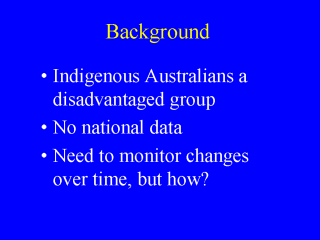|
|
|
|
front |1 |2 |3 |4 |5 |6 |7 |8 |9 |10 |11 |12 |13 |14 |15 |16 |17 |18 |19 |20 |21 |22 |23 |24 |25 |26 |27 |28 |29 |30 |31 |32 |33 |34 |review |
 |
It is widely agreed that Indigenous Australians suffer the greatest health disadvantages of any group in Australia, but there has historically been little information available at the national or state/territory level about the health and well-being of this population sub-group. The National Centre for Aboriginal and Torres Strait Islander Statistics was created in 1995 to try to fill this gap, but the staff faced serious limitations relating to the availability and quality of relevant data. Health policy-makers and service providers wanted to know about the current health status of the Indigenous population, which was hard enough, but they also wanted to know whether, and to what extent, things were changing over time, and whether there were differences from place to place. They needed to know this in order to make funding decisions and to monitor the impact of various policies and programs aimed at improving the health of Indigenous Australians. |